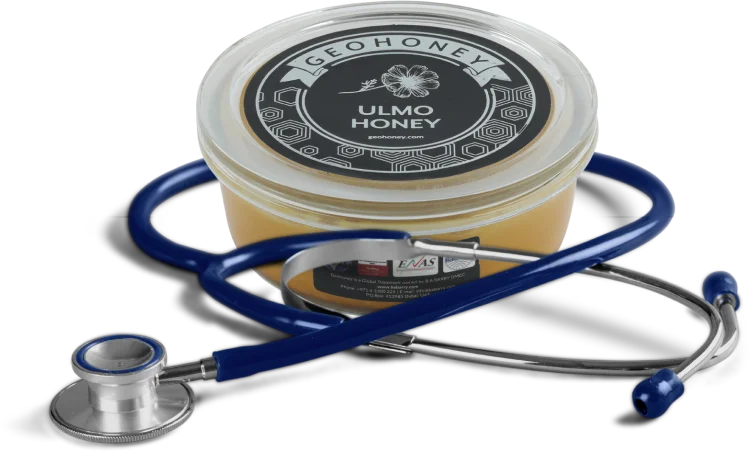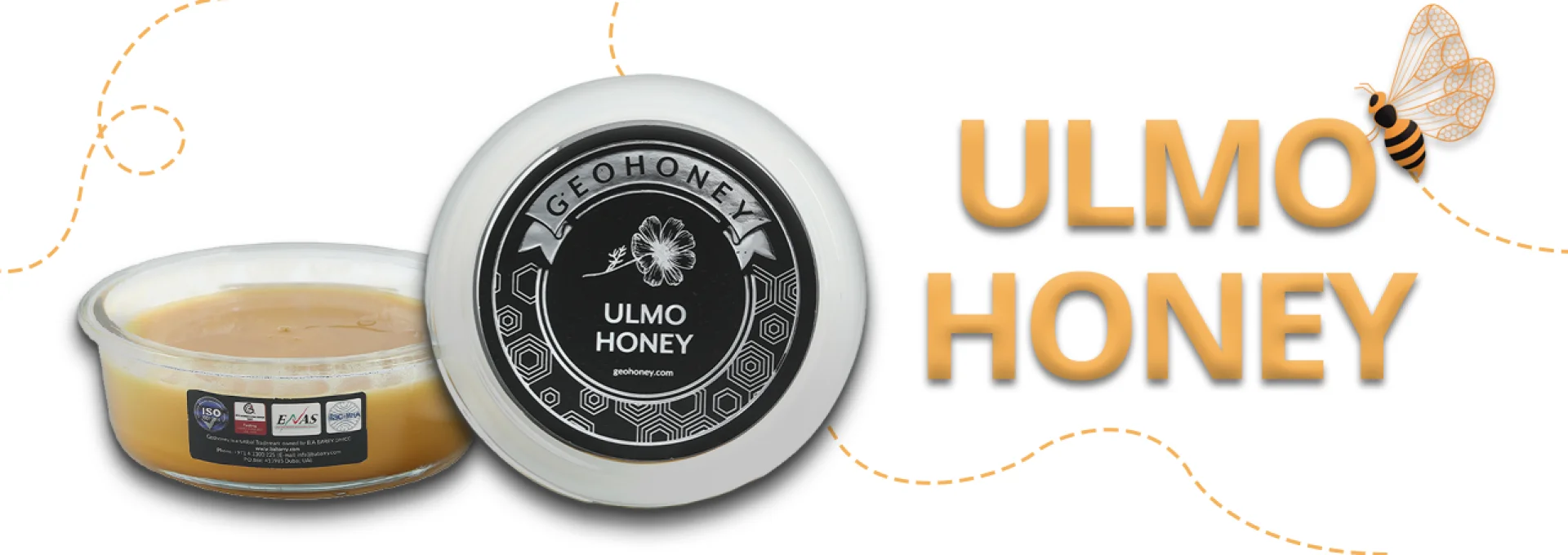Comprehensive Detailed Guide about Ulmo Honey
Table Of Contents

- What is ulmo?
- What is ulmo honey?
- Properties of Ulmo honey
- Health benefits of Ulmo honey
- Antibacterial and anti-infective characteristics
- Economic and environmental significance of Ulmo tree honey
- The appearance of Ulmo honey
- Ulmo honey kills MRSA better than manuka honey UMF25+
- Takeaway
- Head over to Geohoney to grab a jar today!
What is ulmo??
Ulmo is a 35-meter-tall evergreen tree that grows in an emergent posture in the forest canopy. Hardy prefers well-drained soil. It can grow in semi-shade (light woods) or full sunlight.


what is ulmo honey?
It is the honey produced by bees when they primarily suck the blooms of Ulmo. Ulmo (Eucryphia cordifolia) is a Chilean tree native to the Andes mountain region, with white, scented blossoms.
This honey comes from the forests of Ulmos in Chile's south. Although its producing region is limited to three countries: Chile, Australia, and Tasmania, Ulmo honey is considered of exceptional quality and is highly valued in worldwide markets.
Properties of Ulmo honey
Ulmo honey has the highest concentration of antibacterial and fungicidal characteristics, thus it can be used externally to treat wounds, skin fungi, and other skin problems.
The prospect of employing it as a fungicide and bactericide in the treatment of plant pests and diseases is being researched due to its high antibacterial and antifungal ability.

Ulmo honey is a unique type of monofloral honey produced in Argentina and Chile from the flower nectar and pollen of Ulmo trees of the species Eucryphia cordifolia. According to research, Ulmo tree honey has a high antibacterial activity against antibiotic-resistant types of bacteria such as E. coli and Staphylococcus aureus. Furthermore, honey has antifungal action, and tonic characteristics, aids in the treatment of respiratory tracts infection symptoms such as coughing or sore throat, aids in the treatment of weariness and provides digestive advantages.
Ulmo trees of the species Eucryphia cordifolia are scarce and restricted to the South American Andes, a mountain range in the continent's west. Argentina and Chile currently have the most tree species populations. The vast majority of honey is produced in Chile, where there are enough tree specimens to feed bee colonies while also supporting honey production. From February to the end of April, Ulmo trees bloom and produce four-petaled white blooms rich in delicious and fragrant nectar that honey bees capture and utilize for nutrition and honey production.

Health benefits of Ulmo honey
Ulmo honey has antifungal action, and tonic characteristics, aids in the treatment of respiratory tracts infection symptoms such as cough or sore throat, helps combat weariness and provides digestive benefits.
It has potent anti-inflammatory qualities and benefits convalescents as well as individuals suffering from nutritional deficits and eating disorders.
Ulmo honey contains potent antibacterial effects.

-
Antibacterial and anti-infective characteristics
Ulmo honey is a powerful natural antibacterial and antibiotic, owing to its high concentration of hydrogen peroxide, a natural antimicrobial found in all honey kinds. The honey's low moisture content and pH also contribute to these effects, restricting bacteria spread and lowering bacteria numbers.
Furthermore, Ulmo honey, like all honey, includes various levels of plant pollen, which has been demonstrated to have immunomodulatory qualities, which means it promotes the immune system's response to infection and sickness. Pollen, on the other hand, is a source of allergies in addition to strengthening immunity. Anyone who is allergic to Ulmo pollen or numerous pollens should avoid Ulmo honey. Additionally, anyone who is allergic to honey bee enzymes employed in the manufacturing of honey should avoid honey in general, as well as all of its products (oval jelly, bee bread, and so on). -
Aids in the healing of wounds quickly
Ulmo honey is thought to promote faster healing of wounds for skin injuries, scratches, cuts or breaks in the skin, even insect bites, ulcers, blemishes and acne, scars burns, or varicose (vascular, venous) ulcers due to its strong antibacterial, antiseptic, antibiotic, and antifungal characteristics. However, simply applying honey to the skin will not cure a wound because certain formulations with appropriate concentrations are necessary for such benefits, thus seek quick medical attention for wound care.
-
benefecial for gastritis and stomach ulcers
Ulmo honey is consumed first thing in the morning on an empty stomach to help heal stomach ulcers and gastritis. Honey's antimicrobial and calming properties are thought to protect and promote the healing of the stomach lining. It is advised to postpone eating and drinking for up to an hour after the honey has been consumed and to continue to eat the honey over several weeks. However, keep in mind that honey does not substitute prescription meds or a rigorous gastritis diet, so speak to a doctor about including it in your nutrition as an alternative, supplementary treatment option.
-
Homeopathic treatment for cough and sore throat
Ulmo honey is an excellent natural therapy for respiratory infections, aiding in both infection control and symptom relief. The type soothes coughs and sore throats by forming a protective layer over the throat lining, limiting additional inflammation and letting it heal. It is advised to consume one teaspoon of honey 4-to 5 times per day and to refrain from eating or drinking for up to an hour after taking it.
-
It possesses modest prebiotic effects
Ulmo honey contains natural sugars that feed the healthy bacteria in the digestive system, giving it prebiotic characteristics and contributing to digestive health.
-
Aids in the treatment of tiredness and hypoglycemia
The variety is an excellent natural tonic that boosts energy levels, increases hunger, and combats weariness and hypoglycemia due to its stimulating characteristics.
-
Source of vitamins and minerals
Ulmo, like all honey, includes trace levels of vitamins and minerals such as vitamin C, B vitamins, potassium, calcium, iron, magnesium, phosphorus, and others. Furthermore, its nutritional profile is boosted by the presence of trace levels of other nutrients, most notably amino acids, pollen, propolis, different enzymes, and other nutritionally valuable particles. All of these ingredients add to honey's nutritional value.
economic and environmental significance of Ulmo tree honey
Ulmo honey is valued not just for its nutritional and physiological benefits, but also its economic and environmental impact. The logging industry is interested in Ulmo wood because of its resistance and appearance, which endangers the species' survival. The growing popularity of Ulmo honey, which provides a different economic value to the tree species, is currently the single most effective deterrent to excessive logging and a means of preserving the species. Ulmo honey production has a positive ecological impact by providing economic value and aiding in the propagation of the species through pollination by honey bees.


The appearance of Ulmo honey
The color of the variety is often light amber (cloudy-milky yellow) and opaque, which is due to its thick, creamy, curd-like consistency (think about lemon curd or orange curd).
Ulmo honey kills MRSA better than manuka honey UMF25+
The study "Comparison of the antimicrobial activity of Ulmo honey from Chile and Manuka honey against methicillin-resistant Staphylococcus aureus, Escherichia coli, and Pseudomonas aeruginosa," conducted and published in 2010 by Orla Sherlock from Ireland, tested the antimicrobial activity of Chilean honey made by Apis mellifera (honeybee) originating from the Ulmo tree (Eucryphia cordifolia)
Three types of honey were used in the study: – Manuka honey with UMF® 25+
Honey Ulmo 90 (Rio San Pedro Ltd. Chile) The percentage of Ulmo nectar in that honey is 90. The remaining 10% comes from various Chilean plant species.
For control, a laboratory-generated (fake) honey was used.
Ulmo 90 honey was found to have stronger antibacterial activity against all MRSA isolates tested than manuka honey, as well as similar efficacy against E. coli and P. aeruginosa.
- MRSA – superior to manuka honey
- Escherichia coli is as effective as manuka honey.
- Pseudomonas aeruginosa — as effective as manuka honey
Unlike Manuka honey, which has a high concentration of MGO (methylglyoxal), Ulmo 90 honey's activity is mostly due to hydrogen peroxide generation.
This indicates that Ulmo honey has strong antibacterial capabilities only when it is new (within the first three months of harvest) and stored in cold, dark conditions.
Other honeys that inhibits the growth of MRSA isolates include – manuka honey – Malaysian melaleuca honey, – some Thai honey, particularly from the longan flower, – buckwheat and heather from Finland, – and red honey from Ethiopia, etc.
Honey contains antioxidant, anti-inflammatory, and antibacterial qualities that help cure venous ulcers and burns.
The article Combined therapy of Ulmo honey (Eucryphia cordifolia) and ascorbic acid to treat venous ulcers., published in 2015 by Calderon Mdel S et al, evaluated the clinical efficacy of topical Ulmo honey treatment combined with oral ascorbic acid in patients with venous ulcers.
Ulmo honey was applied topically twice a day, and 500 mg of ascorbic acid was taken orally once a day. The honey had debriding and non-adherent qualities were simple to apply and remove and were highly received by users.
The treatment produced outstanding clinical results in the treatment of venous ulcers.
Carolina Schencke's 2015 study Healing Effect of Ulmo Honey (Eucryphia cordifolia) Supplemented with Ascorbic Acid as Treatment in Burns morphology assessed wound healing of type B burns on 15 guinea pigs.
This study found that supplementing Ulmo honey with ascorbic acid promotes faster healing in burn wounds as compared to unsupplemented Ulmo honey.
The quick healing was caused by increased tissue creation, fibroblast activity, and rapid keratinocyte/connective tissue re-epithelialization 14 days after the injury. Unsupplemented Ulmo honey, on the other hand, did not regenerate the epidermal layer and displayed an initial proliferative phase, indicating that ascorbic acid scavenged reactive oxygen species (ROS), boosting honey's anti-inflammatory action.

Takeaway
The major takeaway about Ulmo honey is its benefits over manuka honey in killing MSMA more efficiently while also providing the additional benefits of being a natural sweetener.
Buy Our Ulmo Honey
What’s the buzz, Join the hive !
SIGN UP TO OUR NEWSLETTER
Be the first to know about our hot deals, new arrivals.






 Pay By Cards
Pay By Cards
 PayPal
PayPal
 Stripe
Stripe
 Other Payment Methods
Other Payment Methods










